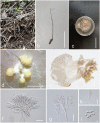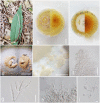Four novel Pleurocordyceps (Polycephalomycetaceae) species from China
- PMID: 38268701
- PMCID: PMC10807425
- DOI: 10.3389/fmicb.2023.1256967
Four novel Pleurocordyceps (Polycephalomycetaceae) species from China
Abstract
Entomopathogenic fungi comprise an ecologically important group of specialized pathogens infecting other fungi, invertebrates, and plants. These fungi are species-rich with high diversity and broad distribution worldwide. The majority of entomopathogenic fungi belong to clavicipitoids, which consist of the hypocrealean families, Clavicipitaceae, Cordycipitaceae, Ophiocordycipitaceae, and Polycephalomycetaceae. The latter is a newly established entomopathogenic family that recently separated from the family Ophiocordycipitaceae to accommodate the genera, Perennicordyceps, Pleurocordyceps, and Polycephalomyces. In recent years, Polycephalomycetaceae has been enriched with parasitic and hyperparasitic fungi. With 16 species spread across China, Ecuador, Japan, and Thailand, Pleurocordyceps is the most speciose genus in the family. In this study, we expand the number of taxa in the genus by introducing four new Pleurocordyceps species from China, namely, P. clavisynnema, P. multisynnema, P. neoagarica, and P. sanduensis. We provide detailed descriptions and illustrations and infer genus-level phylogenies based on a combined 6-loci gene sequence dataset comprising the internal transcribed spacer gene region (ITS), small subunit ribosomal RNA gene region (SSU), large subunit rRNA gene region (LSU), translation elongation factor 1-alpha gene region (TEF-1α), RNA polymerase II largest subunit gene region (RPB1), and RNA polymerase II second largest subunit (RPB2). This study contributes to knowledge with regard to the diversity of Pleurocordyceps specifically and entomopathogenic Hypocreales more broadly.
Keywords: Polycephalomycetaceae; entomopathogenic fungi; morphology; phylogeny; taxonomy.
Copyright © 2024 Xiao, Yang, Jayawardena, Gentekaki, Peng, Luo and Lu.
Conflict of interest statement
The authors declare that the research was conducted in the absence of any commercial or financial relationships that could be construed as a potential conflict of interest.
Figures





Similar articles
-
Molecular Phylogenetic and Comparative Genomic Analysis of Pleurocordyceps fusiformispora sp. nov. and Perennicordyceps elaphomyceticola in the Family Polycephalomycetaceae.J Fungi (Basel). 2024 Apr 19;10(4):297. doi: 10.3390/jof10040297. J Fungi (Basel). 2024. PMID: 38667968 Free PMC article.
-
Morphology and phylogeny of four new species within Polycephalomycetaceae (Hypocreales) parasitising Ophiocordyceps species.MycoKeys. 2024 May 16;105:179-202. doi: 10.3897/mycokeys.105.119893. eCollection 2024. MycoKeys. 2024. PMID: 38799409 Free PMC article.
-
Redisposition of acremonium-like fungi in Hypocreales.Stud Mycol. 2023 Jun;105:23-203. doi: 10.3114/sim.2023.105.02. Epub 2023 Jun 2. Stud Mycol. 2023. PMID: 38895703 Free PMC article.
-
Phylogeny and species delimitations in the economically, medically, and ecologically important genus Samsoniella (Cordycipitaceae, Hypocreales).MycoKeys. 2023 Oct 3;99:227-250. doi: 10.3897/mycokeys.99.106474. eCollection 2023. MycoKeys. 2023. PMID: 37828936 Free PMC article.
-
Insect pathogens as biological control agents: Back to the future.J Invertebr Pathol. 2015 Nov;132:1-41. doi: 10.1016/j.jip.2015.07.009. Epub 2015 Jul 27. J Invertebr Pathol. 2015. PMID: 26225455 Review.
Cited by
-
Molecular Phylogenetic and Comparative Genomic Analysis of Pleurocordyceps fusiformispora sp. nov. and Perennicordyceps elaphomyceticola in the Family Polycephalomycetaceae.J Fungi (Basel). 2024 Apr 19;10(4):297. doi: 10.3390/jof10040297. J Fungi (Basel). 2024. PMID: 38667968 Free PMC article.
-
Chlorocilliumsinense sp. nov. (Clavicipitaceae) and Calcarisporiumguizhouense sp. nov. (Calcarisporiaceae) in Hypocreales from China.MycoKeys. 2024 Oct 2;109:91-107. doi: 10.3897/mycokeys.109.128060. eCollection 2024. MycoKeys. 2024. PMID: 39391867 Free PMC article.
-
Two new Cordyceps-like species, Perennicordycepszongqii sp. nov. (Polycephalomycetaceae) and Purpureocilliumzongqii sp. nov. (Ophiocordycipitaceae), in Hypocreales from karst region of China.MycoKeys. 2024 Nov 7;110:141-158. doi: 10.3897/mycokeys.110.135724. eCollection 2024. MycoKeys. 2024. PMID: 39552615 Free PMC article.
-
Four new araneogenous species and a new genus in Hypocreales (Clavicipitaceae, Cordycipitaceae) from the karst region of China.MycoKeys. 2025 Jan 23;112:335-359. doi: 10.3897/mycokeys.112.140799. eCollection 2025. MycoKeys. 2025. PMID: 39897122 Free PMC article.
References
-
- Acuña Jiménez M., García Gutiérrez C., Rosas García N. M., López Meyer M., Saínz Hernández J. C. (2015). Formulation of Metarhizium anisopliae (Metschnikoff) Sorokin with biodegradable polymers and their virulence against Heliothis virescens (Fabricius). Rev. Int. Contam. Ambie. 31, 219–226.
-
- Ban S., Sakane T., Toyama K., Nakagiri A. (2009). Teleomorph-anamorph relationships and reclassification of Cordyceps cuboidea and its allied species. Mycoscience 50, 261–272. 10.1007/S10267-008-0480-Y - DOI
-
- Bischoff J. F., Sullivan R. F., Struwe L., Hywel-Jones N. L., White J. F. (2003). Resurrection of Blistum tomentosum and its exclusion from Polycephalomyces (Hyphomycetes, Deuteromycota) based on 28S rDNA sequence data. Mycotaxon 86, 433–444.
LinkOut - more resources
Full Text Sources

